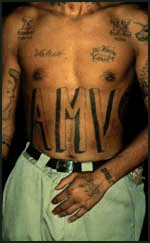
THE STYLE OF VIOLENCE


|
Street gangs have been a long-time media favorite, and the often sensationalist reports about gang activities have contributed to the mystification of the phenomenon. A symbiotic relationship has developed between media and violence that now includes the style of violence, be it in Gangsta Rap or the movies (witness a recent New York Times article on the new "style" of gun-pointing found in recent movies--holding one's weapon sideways is the hip way now). "A Street Guide to Gang Identity"--a project headed by Dr. Janet Hethorn, a researcher from the Department of Environmental Design at the University of California at Davis--is intended to help demystify the visual cues that signify gang identity. The website, based on research that has been conducted since 1990, is anything but sensationalist: avoiding generalization, it succeeds in fostering an improved understanding about the complexities of gang styles, school dress codes, and the link between clothing and violence. Dr. Hethorn--who is currently working on a documentary video and a book on the topic of youth violence and style--began her research on adolescent appearance in the early 1980's with a study on the impact of music videos on fashion change; she approached the topic of Gang ID by exploring the perspectives of the people who are most involved with the situation. The research methods include observations and interviews in street and school settings throughout California and in selected cities nationwide, and the perspectives presented are those of law enforcement, school administrators, and youth, including gang members. The webpages also feature selections from hundreds of photographs of street style which Dr. Hethorn has collected so far. Hand signs as visual symbols of gang identity."A Street Guide to Gang ID" successfully illustrates that an accurate reading of individuals based on their appearance is a complex endeavor. It is not easy to recognize the visual factors that lead to gang identity--a person cannot be identified as a gang member simply by an article of clothing or the color of a hat. (There actually have been instances where deaf people signing have been hurt or killed because they were mistaken for gang members.) Configurations and meanings change, and their understanding is based entirely on the context that the details are seen in. The website features information on complexity factors such as meaning, change, context, fashion and stereotyping and examines "style factors" such as tattoos, posture, hand signs, sportsgear, clothing, accessories, and colors--all presented in different contexts. The practice of pushing one pant leg up currently signifies gang affiliation in Minneapolis (right leg with the Vice Lords and left with the Gangster Disciples), but may just reflect the latest music video trend to influence a style in Tokyo. The street guide illustrates how many symbols and images that were widely used by gang members have quickly found their way into mainstream fashion. The work-clothing style, for example, has moved from gang and prison wear to MTV, to skaters, to an ad on the pages of a major fashion magazine. "A Street Guide to Gang Identity" is far from a complete directory of the symbols of Gang ID, but constantly exemplifies the futility of categorization and stereotyping: by the time you know the meaning, it has already changed. |